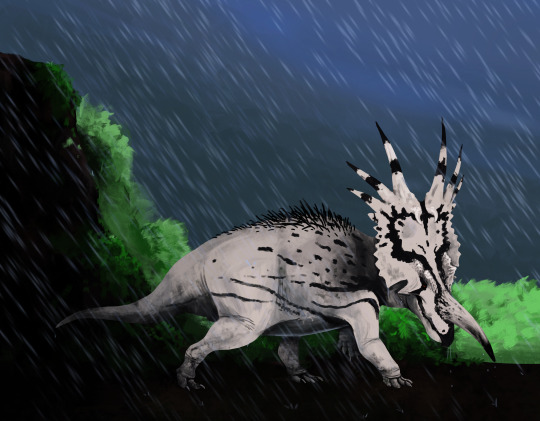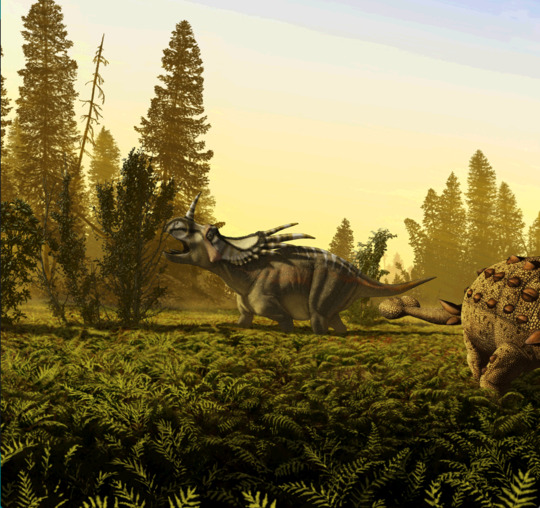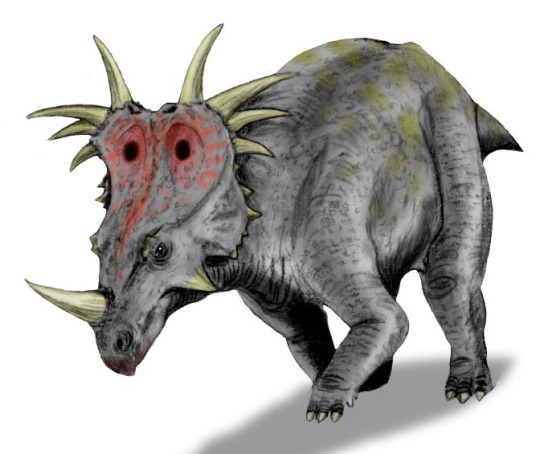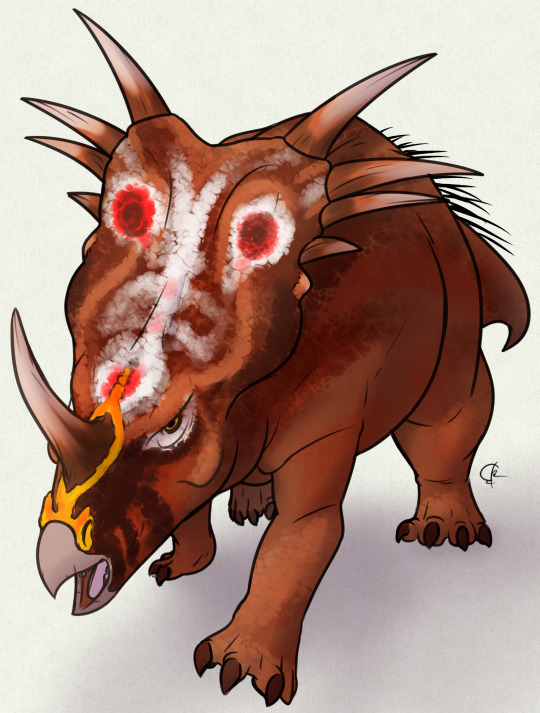#bitchpleasescience
Text
Styracosaurus albertensis

By Jack Wood on @thewoodparable
PLEASE support us on Patreon! We really do need all of your support to keep this blog running - any amount helps!
Name: Styracosaurus albertensis
Name Meaning: Spiked Reptile
First Described: 1913
Described By: Lambe
Classification: Dinosauria, Ornithischia, Genasauria, Neornithischia, Cerapoda, Marginocephalia, Ceratopsia, Neoceratopsia, Coronosauria, Ceratopsoidea, Ceratopsidae, Centrosaurinae, Centrosaurini
Styracosaurus is one of the more famous Ceratopsians, and and for good reason - it’s spectacular horns and frill mark it out as distinctive, and it is fairly well known as well, with many specimens collected and, back in the day, many species assigned to it - though all but the original have now since been assigned their own species. It was large, about 5.5 meters long, standing at about 1.8 meters tall at the hips, and weighing approximately 3 tonnes. It was originally found in the Dinosaur Park Formation of Alberta, Canada, and other specimens found elsewhere have been assigned their own genera. It lived about 75 million years ago, in the Campanian age of the Late Cretaceous.

By Julius Cstonyi, CC BY 2.5
Styracosaurus is distinctive in their massive skulls, with large neck frills with at least four large spikes. These spikes were similar in length to the horn on its nose, which ended in a rounded point. It had other, more variable ornamentation on the frill, with small hook-like projections and knobs on the frill, or less prominent tabs, or a third pair of long spikes, or smaller projections. There were also small, pyramid like brow horns in subadults that would change to pits as the animal aged into an adult; the brow horns being remnants of the brow horns ancestral to all Ceratopsids. It had large openings in its frill, which may have served as platforms for display coloration. It had a toothless beak in the front of its mouth, like other Ceratopsians. It’s frill, in general, seems to have been better built for display, rather than defense; and is probably a remarkable example of the effects of sexual selection on Ceratopsians. It had a very bulky body, like that of modern rhinoceros, which would have allowed it to brace itself when fighting with other members of the species. It also had a very short tail, and hoof-like toe claws.

By Mariana Ruiz Villarreal, in the Public Domain
A bonebed of Styracosaurus individuals is known, but it is associated with varying river deposits, and it is possible that animals simply congregated there to drink during drought and were not truly herd animals. In short, direct evidence of herding behavior isn’t entirely known. It did not have sprawling forelimbs, as was once believed, and it may have been able to run faster than elephants, based on found trackways. It ate plants, though exactly what kind has been up to debate. Its large frill, as stated, was probably used for display rather than defense; this seems to be a common condition of Centrosaurines versus Ceratopsians more closely related to Triceratops, which appear to have used it for defense in addition to any display purposes.

By Nobu Tamura, CC BY 3.0
Styracosaurus was a Centrosaurine, and it’s evolution amongst other Centrosaurines is very well known. It is probably the direct descendant of Centrosaurus, which came earlier, and it replaced Centrosaurus in the typical ecosystem of Late-Cretaceous North America in terms of niche, as the two are not found alongside one another. It then is thought to have evolved into the similar Rubeosaurus, which is known from slightly later. It is probably much more complex than this, however, the closeness in relation of all these species cannot be denied, especially given that Rubeosaurus was originally described as a species of Styracosaurus, and Styracosaurus shared many similar features to Centrosaurus.

By José Carlos Cortés on @ryuukibart
Styracosaurus lived in a very diverse and complex community in the Dinosaur Park Formation with many famous dinosaurs, specifically Vagaceratops, Lambeosaurus, Prosaurolophus, Daspletosaurus, which may have preyed upon it, and others whose time in the formation is ambiguous. Troodon, Saurornitholestes, Richardoestesia, Hesperonychus, Dromaeosaurus, Leptorhynchos, Chirostenotes, Caenagnathus, Ornithomimus, Struthiomimus, Rativates, Stegoceras, Gravitholus, and Unescoceratops might have lived alongside it as well. It lived in a floodplain environment, near the coast of the Inland Sea that existed in Cretaceous at that time.
Sources:
https://en.wikipedia.org/wiki/Styracosaurus
https://en.wikipedia.org/wiki/Dinosaur_Park_Formation
Shout out goes to @bitchpleasescience!
#styracosaurus#styracosaurus albertensis#dinosaur#ceratopsian#palaeoblr#bitchpleasescience#paleontology#prehistory#prehistoric life#dinosaurs#biology#a dinosaur a day#a-dinosaur-a-day#dinosaur of the day#dinosaur-of-the-day#science#nature#factfile#Dìneasar#डायनासोर#ديناصور#ডাইনোসর#risaeðla#ڈایناسور#deinosor#恐龍#恐龙#динозавр#dinosaurio#공룡
124 notes
·
View notes